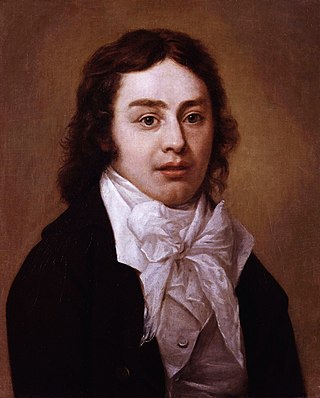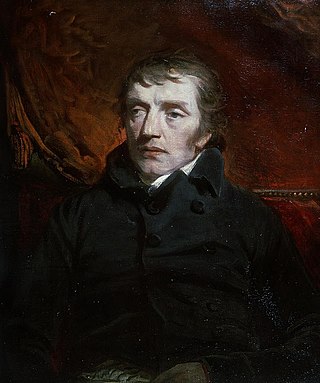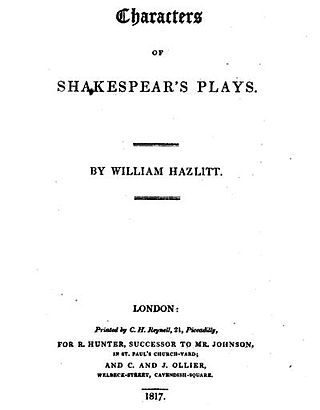
Samuel Taylor Coleridge was an English poet, literary critic, philosopher, and theologian who, with his friend William Wordsworth, was a founder of the Romantic Movement in England and a member of the Lake Poets. He also shared volumes and collaborated with Charles Lamb, Robert Southey, and Charles Lloyd. He wrote the poems The Rime of the Ancient Mariner and Kubla Khan, as well as the major prose work Biographia Literaria. His critical work, especially on William Shakespeare, was highly influential, and he helped introduce German idealist philosophy to English-speaking cultures. Coleridge coined many familiar words and phrases, including "suspension of disbelief". He had a major influence on Ralph Waldo Emerson and American transcendentalism.

Robert Southey was an English poet of the Romantic school, and Poet Laureate from 1813 until his death. Like the other Lake Poets, William Wordsworth and Samuel Taylor Coleridge, Southey began as a radical but became steadily more conservative as he gained respect for Britain and its institutions. Other romantics such as Byron accused him of siding with the establishment for money and status. He is remembered especially for the poem "After Blenheim" and the original version of "Goldilocks and the Three Bears".

William Hazlitt was an English essayist, drama and literary critic, painter, social commentator, and philosopher. He is now considered one of the greatest critics and essayists in the history of the English language, placed in the company of Samuel Johnson and George Orwell. He is also acknowledged as the finest art critic of his age. Despite his high standing among historians of literature and art, his work is currently little read and mostly out of print.

Thomas Penson De Quincey was an English writer, essayist, and literary critic, best known for his Confessions of an English Opium-Eater (1821). Many scholars suggest that in publishing this work De Quincey inaugurated the tradition of addiction literature in the West.
This article contains information about the literary events and publications of 1794.

Charles Lamb was an English essayist, poet, and antiquarian, best known for his Essays of Elia and for the children's book Tales from Shakespeare, co-authored with his sister, Mary Lamb (1764–1847).

William Gifford was an English critic, editor and poet, famous as a satirist and controversialist.
Nationality words link to articles with information on the nation's poetry or literature.
Robert Allen (1772–1805) was a British journalist and surgeon, famous for having introduced Robert Southey and Samuel Taylor Coleridge.
Sonnets on Eminent Characters or Sonnets on Eminent Contemporaries is an 11-part sonnet series created by Samuel Taylor Coleridge and printed in the Morning Chronicle between 1 December 1794 and 31 January 1795. Although Coleridge promised to have at least 16 poems within the series, only one addition poem, "To Lord Stanhope", was published.

Characters of Shakespear's Plays is an 1817 book of criticism of Shakespeare's plays, written by early nineteenth century English essayist and literary critic William Hazlitt. Composed in reaction to the neoclassical approach to Shakespeare's plays typified by Samuel Johnson, it was among the first English-language studies of Shakespeare's plays to follow the manner of German critic August Wilhelm Schlegel, and, with the work of Samuel Taylor Coleridge, paved the way for the increased appreciation of Shakespeare's genius that was characteristic of later nineteenth-century criticism. It was also the first book to cover all of Shakespeare's plays, intended as a guide for the general reader.

The Feast of the Poets is a poem by Leigh Hunt that was originally published in 1811 in the Reflector. It was published in an expanded form in 1814, and revised and expanded throughout his life. The work describes Hunt's contemporary poets, and either praises or mocks them by allowing only the best to dine with Apollo. The work also provided commentary on William Wordsworth and Romantic poetry. Critics praised or attacked the work on the basis of their sympathies towards Hunt's political views.

William Hazlitt was a Unitarian minister and author, and the father of the Romantic essayist and social commentator of the same name. He was an important figure in eighteenth-century English and American Unitarianism, and had a major influence on his son's work.

Peter Bell: A Tale in Verse is a long narrative poem by William Wordsworth, written in 1798, but not published until 1819.

John Hazlitt was an English artist who specialised in miniature portrait painting. He was the eldest brother of William Hazlitt – a major essayist of the English Romantic period, as well as an artist and radical social commentator – and had a significant influence on his career.

The Spirit of the Age is a collection of character sketches by the early 19th century English essayist, literary critic, and social commentator William Hazlitt, portraying 25 men, mostly British, whom he believed to represent significant trends in the thought, literature, and politics of his time. The subjects include thinkers, social reformers, politicians, poets, essayists, and novelists, many of whom Hazlitt was personally acquainted with or had encountered. Originally appearing in English periodicals, mostly The New Monthly Magazine in 1824, the essays were collected with several others written for the purpose and published in book form in 1825.

Table-Talk is a collection of essays by the English cultural critic and social commentator William Hazlitt. It was originally published as two volumes, the first of which appeared in April 1821. The essays deal with topics such as art, literature and philosophy. Duncan Wu has described the essays as the "pinnacle of [Hazlitt's] achievement", and argues that Table-Talk and The Plain Speaker (1826) represent Hazlitt's masterpiece.
The Round Table is a collection of essays by William Hazlitt and Leigh Hunt published in 1817. Hazlitt contributed 40 essays, while Hunt submitted 12.

Romanticism was an artistic, literary, and intellectual movement that originated in Europe toward the end of the 18th century. Scholars regard the publishing of William Wordsworth's and Samuel Coleridge's Lyrical Ballads in 1798 as probably the beginning of the movement, and the crowning of Queen Victoria in 1837 as its end. Romanticism arrived in other parts of the English-speaking world later; in the United States, it arrived around 1820.
Sarah Stoddart Hazlitt (1774–1843) was an English journalist and walker, and wife of the essayist William Hazlitt.














